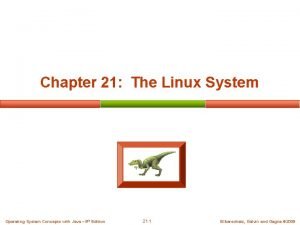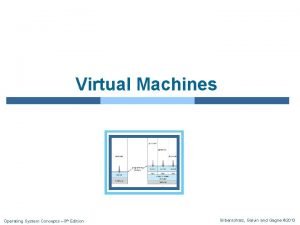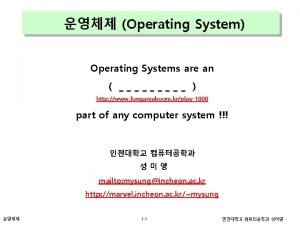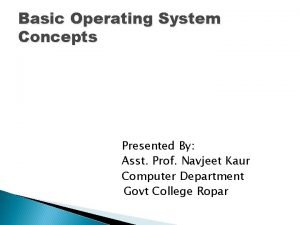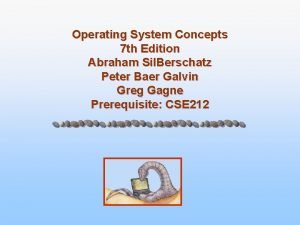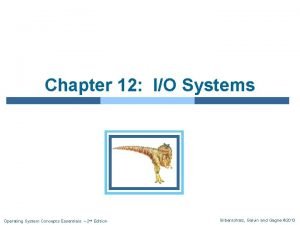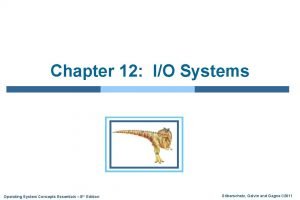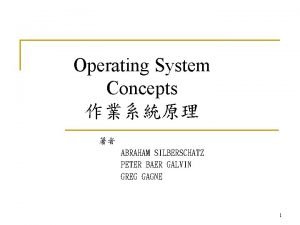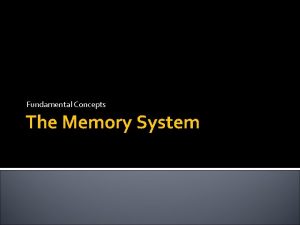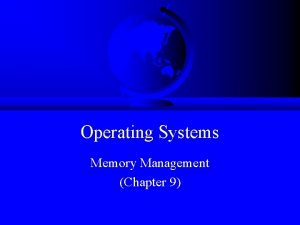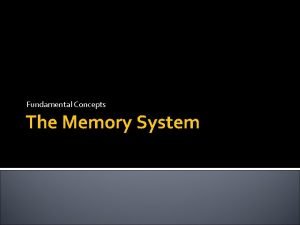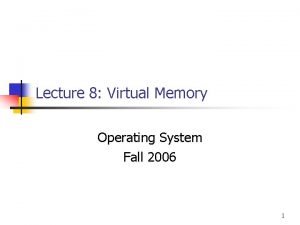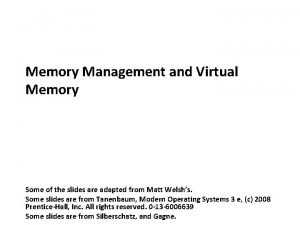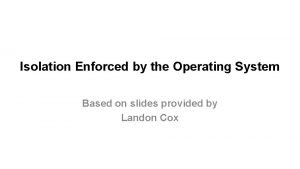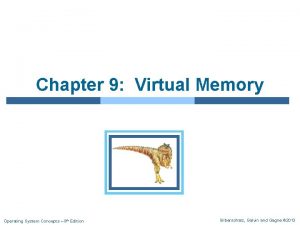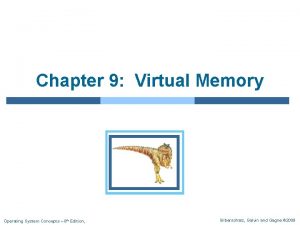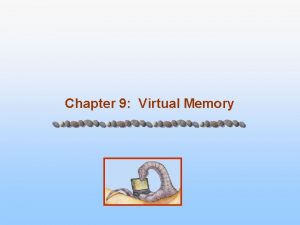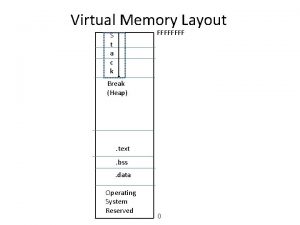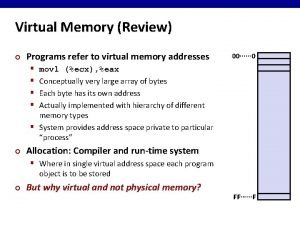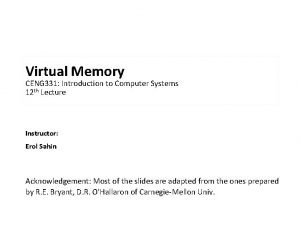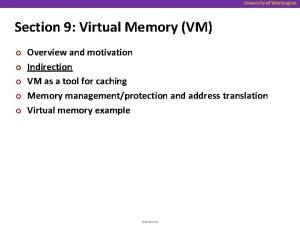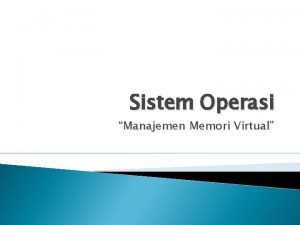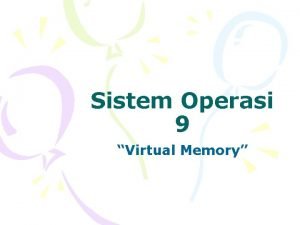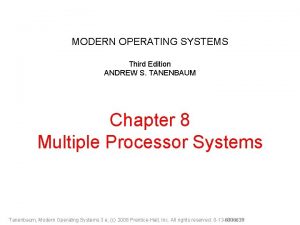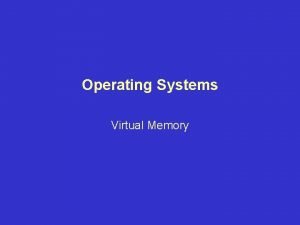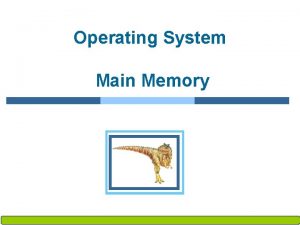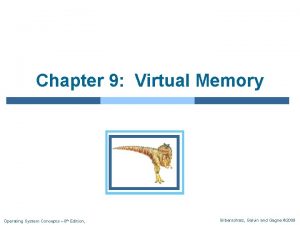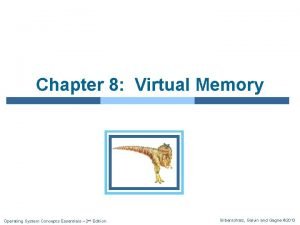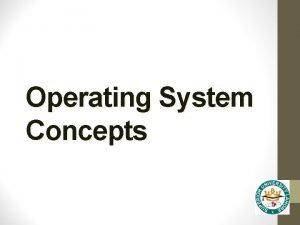Chapter 9 Virtual Memory Operating System Concepts 9









































![Program Structure n Program structure l int[128, 128] data; stored row major Each row Program Structure n Program structure l int[128, 128] data; stored row major Each row](https://slidetodoc.com/presentation_image_h/95eaf0aa7a2ef177a57a0fb0694620b0/image-42.jpg)























![Other Issues – Program Structure n Program structure l int[128, 128] data; Each row Other Issues – Program Structure n Program structure l int[128, 128] data; Each row](https://slidetodoc.com/presentation_image_h/95eaf0aa7a2ef177a57a0fb0694620b0/image-66.jpg)


- Slides: 68

Chapter 9: Virtual Memory Operating System Concepts – 9 th Edition Silberschatz, Galvin and Gagne © 2013

Chapter 9: Virtual Memory n Background n Demand Paging n Copy-on-Write n Page Replacement n Allocation of Frames n Thrashing n Memory-Mapped Files n Allocating Kernel Memory n Other Considerations n Operating-System Examples Operating System Concepts – 9 th Edition 9. 2 Silberschatz, Galvin and Gagne © 2013

Objectives n To describe the benefits of a virtual memory system n To explain the concepts of demand paging, page-replacement algorithms, and allocation of page frames n To discuss the principle of the working-set model n To examine the relationship between shared memory and memory-mapped files n To explore how kernel memory is managed Operating System Concepts – 9 th Edition 9. 3 Silberschatz, Galvin and Gagne © 2013

Virtual Memory That is Larger Than Physical Memory Operating System Concepts – 9 th Edition 9. 4 Silberschatz, Galvin and Gagne © 2013

Shared Library Using Virtual Memory Operating System Concepts – 9 th Edition 9. 5 Silberschatz, Galvin and Gagne © 2013

Page Tables Example: A system with 16 -bit virtual and physical addresses and 4, 096 -byte pages. Convert the virtual addresses (in hexadecimal) to the equivalent physical addresses in hexadecimal or decimal. . 0 x. E 12 C 0 x 3 A 9 D 0 x. A 9 D 9 0 x 7001 0 x. ACA 1 Operating System Concepts – 9 th Edition 9. 6 Silberschatz, Galvin and Gagne © 2013

Demand Paging n Could bring entire process into memory at load time n Or bring a page into memory only when it is needed l Less I/O needed, no unnecessary I/O Less memory needed l Faster response l More users n Similar to paging system with swapping (diagram on right) n Page is needed reference to it l invalid reference abort l not-in-memory bring to memory n Lazy swapper – never swaps a page into memory unless page will be needed l Swapper that deals with pages is a pager l Operating System Concepts – 9 th Edition 9. 7 Silberschatz, Galvin and Gagne © 2013

Basic Concepts n With swapping, pager guesses which pages will be used before swapping out again n Instead, pager brings in only those pages into memory n How to determine that set of pages? l Need new MMU functionality to implement demand paging n If pages needed are already memory resident l No difference from non demand-paging n If page needed and not memory resident l Need to detect and load the page into memory from storage 4 Without changing program behavior 4 Without programmer needing to change code Operating System Concepts – 9 th Edition 9. 8 Silberschatz, Galvin and Gagne © 2013

Valid-Invalid Bit n With each page table entry a valid–invalid bit is associated (v in-memory – memory resident, i not-in-memory) n Initially valid–invalid bit is set to i on all entries n Example of a page table snapshot: n During MMU address translation, if valid–invalid bit in page table entry is i page fault Operating System Concepts – 9 th Edition 9. 9 Silberschatz, Galvin and Gagne © 2013

Page Table When Some Pages Are Not in Main Memory Operating System Concepts – 9 th Edition 9. 10 Silberschatz, Galvin and Gagne © 2013

Page Fault n If there is a reference to a page, first reference to that page will 1. 2. 3. 4. 5. trap to operating system: page fault Operating system looks at another table to decide: l Invalid reference abort l Just not in memory Find free frame Swap page into frame via scheduled disk operation Reset tables to indicate page now in memory Set validation bit = v Restart the instruction that caused the page fault Operating System Concepts – 9 th Edition 9. 11 Silberschatz, Galvin and Gagne © 2013

Steps in Handling a Page Fault Operating System Concepts – 9 th Edition 9. 12 Silberschatz, Galvin and Gagne © 2013

Aspects of Demand Paging n Extreme case – start process with no pages in memory l OS sets instruction pointer to first instruction of process, nonmemory-resident -> page fault l And for every other process pages on first access l Pure demand paging n Actually, a given instruction could access multiple pages -> multiple page faults l Consider fetch and decode of instruction which adds 2 numbers from memory and stores result back to memory l Pain decreased because of locality of reference n Hardware support needed for demand paging l Page table with valid / invalid bit l Secondary memory (swap device with swap space) l Instruction restart Operating System Concepts – 9 th Edition 9. 13 Silberschatz, Galvin and Gagne © 2013

Performance of Demand Paging n Stages in Demand Paging (worse case) 1. Trap to the operating system 2. Save the user registers and process state 3. Determine that the interrupt was a page fault 4. Check that the page reference was legal and determine the location of the page on the disk 5. Issue a read from the disk to a free frame: 1. Wait in a queue for this device until the read request is serviced 2. Wait for the device seek and/or latency time 3. Begin the transfer of the page to a free frame 6. While waiting, allocate the CPU to some other user 7. Receive an interrupt from the disk I/O subsystem (I/O completed) 8. Save the registers and process state for the other user 9. Determine that the interrupt was from the disk 10. Correct the page table and other tables to show page is now in memory 11. Wait for the CPU to be allocated to this process again 12. Restore the user registers, process state, and new page table, and then resume the interrupted instruction Operating System Concepts – 9 th Edition 9. 14 Silberschatz, Galvin and Gagne © 2013

Performance of Demand Paging (Cont. ) n Three major activities l Service the interrupt – careful coding means just several hundred instructions needed l Read the page – lots of time l Restart the process – again just a small amount of time n Page Fault Rate 0 p 1 l if p = 0 no page faults l if p = 1, every reference is a fault n Effective Access Time (EAT) EAT = (1 – p) x memory access + p (page fault overhead + swap page out + swap page in ) Operating System Concepts – 9 th Edition 9. 15 Silberschatz, Galvin and Gagne © 2013

Demand Paging Example n Memory access time = 200 nanoseconds n Average page-fault service time = 8 milliseconds n EAT = (1 – p) x 200 + p (8 milliseconds) = (1 – p x 200 + p x 8, 000 = 200 + p x 7, 999, 800 n If one access out of 1, 000 causes a page fault, then EAT = 8. 2 microseconds. This is a slowdown by a factor of 40!! n If want performance degradation < 10 percent l 220 > 200 + 7, 999, 800 x p 20 > 7, 999, 800 x p l p <. 0000025 l < one page fault in every 400, 000 memory accesses Operating System Concepts – 9 th Edition 9. 16 Silberschatz, Galvin and Gagne © 2013

What Happens if There is no Free Frame? n Used up by process pages n Also in demand from the kernel, I/O buffers, etc n How much to allocate to each? n Page replacement – find some page in memory, but not really in use, page it out l Algorithm – terminate? swap out? replace the page? l Performance – want an algorithm which will result in minimum number of page faults n Same page may be brought into memory several times Operating System Concepts – 9 th Edition 9. 17 Silberschatz, Galvin and Gagne © 2013

Page Replacement n Prevent over-allocation of memory by modifying page- fault service routine to include page replacement n Use modify (dirty) bit to reduce overhead of page transfers – only modified pages are written to disk n Page replacement completes separation between logical memory and physical memory – large virtual memory can be provided on a smaller physical memory Operating System Concepts – 9 th Edition 9. 18 Silberschatz, Galvin and Gagne © 2013

Need For Page Replacement Operating System Concepts – 9 th Edition 9. 19 Silberschatz, Galvin and Gagne © 2013

Basic Page Replacement 1. Find the location of the desired page on disk 2. Find a free frame: - If there is a free frame, use it - If there is no free frame, use a page replacement algorithm to select a victim frame - Write victim frame to disk if dirty 3. Bring the desired page into the (newly) free frame; update the page and frame tables 4. Continue the process by restarting the instruction that caused the trap Note now potentially 2 page transfers for page fault – increasing EAT Operating System Concepts – 9 th Edition 9. 20 Silberschatz, Galvin and Gagne © 2013

Page Replacement Operating System Concepts – 9 th Edition 9. 21 Silberschatz, Galvin and Gagne © 2013

Page and Frame Replacement Algorithms n Frame-allocation algorithm determines l How many frames to give each process l Which frames to replace n Page-replacement algorithm l Want lowest page-fault rate on both first access and re-access n Evaluate algorithm by running it on a particular string of memory references (reference string) and computing the number of page faults on that string l String is just page numbers, not full addresses l Repeated access to the same page does not cause a page fault l Results depend on number of frames available n In all our examples, the reference string of referenced page numbers is 7, 0, 1, 2, 0, 3, 0, 4, 2, 3, 0, 3, 2, 1, 2, 0, 1, 7, 0, 1 Operating System Concepts – 9 th Edition 9. 22 Silberschatz, Galvin and Gagne © 2013

Graph of Page Faults Versus The Number of Frames Operating System Concepts – 9 th Edition 9. 23 Silberschatz, Galvin and Gagne © 2013

FIFO Page Replacement 7, 0, 1, 2, 0, 3, 0, 4, 2, 3, 0, 3, 2, 1, 2, 0, 1, 7, 0, 1 15 page faults Operating System Concepts – 9 th Edition 9. 24 Silberschatz, Galvin and Gagne © 2013

FIFO is “weird” too. . n To illustrate the “weirdness” of FIFO, consider the following reference string 1, 2, 3, 4, 1, 2, 5, 1, 2, 3, 4, 5 Compute the number of page faults for this reference string with (a) 3 frames (b) 4 frames (DONE IN CLASS) Operating System Concepts – 9 th Edition 9. 25 Silberschatz, Galvin and Gagne © 2013

FIFO Illustrating Belady’s Anomaly Operating System Concepts – 9 th Edition 9. 26 Silberschatz, Galvin and Gagne © 2013

Optimal Page Replacement n An optimal page replacement algorithm has the lowest page-fault rate of all algorithms and will never suffer from Belady’s anomaly n Such an algorithm does exist and has been called OPT or MIN. It is simply this: Replace the page that will not be used for the longest period of time n Use of this page-replacement algorithm guarantees the lowest possible page-fault rate for a fixed number of pages (Duh…) Operating System Concepts – 9 th Edition 9. 27 Silberschatz, Galvin and Gagne © 2013

Optimal Page Replacement 7, 0, 1, 2, 0, 3, 0, 4, 2, 3, 0, 3, 2, 1, 2, 0, 1, 7, 0, 1 9 page faults Operating System Concepts – 9 th Edition 9. 28 Silberschatz, Galvin and Gagne © 2013

Optimal Page Replacement n Unfortunately, OPT is difficult to implement, because it requires future knowledge of the reference string n As a result, OPT is used mainly for comparison purposes n For instance, it may be useful to know that, although a new page- replacement algorithm is not optimal, it is within 12. 3 % of optimal at worst and within 4. 7 % on average Operating System Concepts – 9 th Edition 9. 29 Silberschatz, Galvin and Gagne © 2013

Least Recently Used (LRU) Algorithm n If OPT is not feasible, perhaps an approximation of OPT is possible n The key distinction between FIFO and OPT (other than looking backward versus forward in time) is that FIFO uses the time when a page was brought into memory whereas OPT uses the time when a page is to be used n If we use the recent past as an approximation of the near future, then we can replace the page that has not been used for the longest period of time n This approach is the least-recently-used (LRU) algorithm Operating System Concepts – 9 th Edition 9. 30 Silberschatz, Galvin and Gagne © 2013

Least Recently Used (LRU) Algorithm n LRU associates with each page the time of that page’s last use n When a page must be replaced, LRU chooses the page that has not been used for the longest period of time n We can think of this strategy as OPT looking backward in time, rather than forward Operating System Concepts – 9 th Edition 9. 31 Silberschatz, Galvin and Gagne © 2013

LRU Page Replacement 7, 0, 1, 2, 0, 3, 0, 4, 2, 3, 0, 3, 2, 1, 2, 0, 1, 7, 0, 1 12 page faults Operating System Concepts – 9 th Edition 9. 32 Silberschatz, Galvin and Gagne © 2013

LRU Page Replacement n LRU is designed to take advantage of “normal” program behavior n Programs are written to contain loops, which cause the main line of the code to execute repeatedly, with special-case code rarely being executed n This set of pages that contain the code that is executed repeatedly is called the code locality of the process n The LRU replacement algorithm is explicitly designed to take advantage of locality by assuming that if a page has been referenced recently, it is likely to be referenced again soon Operating System Concepts – 9 th Edition 9. 33 Silberschatz, Galvin and Gagne © 2013

LRU Page Replacement n LRU is often used as a page replacement algorithm and is considered to be good n The major problem is how to implement LRU replacement n An LRU page replacement algorithm may require substantial hardware assistance Operating System Concepts – 9 th Edition 9. 34 Silberschatz, Galvin and Gagne © 2013

Use Of A Stack to Record Most Recent Page References Operating System Concepts – 9 th Edition 9. 35 Silberschatz, Galvin and Gagne © 2013

LRU Approximation Algorithms n Reference bit l With each page associate a bit, initially = 0 l When page is referenced bit set to 1 l Replace the one which is 0 (if one exists). We do not know the order, however l This information is the basis for many page-replacement algorithms that approximate LRU replacement (e. g. , the Second-chance algorithm) n Second chance l Need reference bit l FIFO algorithm but give “second chance” to a page l If page to be replaced (in clock order) has reference bit = 1 then: 4 set reference bit 0 4 leave page in memory 4 replace Operating System Concepts – 9 th Edition next page (in clock order), subject to same rules 9. 36 Silberschatz, Galvin and Gagne © 2013

Second-Chance (clock) Page-Replacement Algorithm Operating System Concepts – 9 th Edition 9. 37 Silberschatz, Galvin and Gagne © 2013

Enhanced Second-Chance Algorithm n Improve algorithm by using reference bit and modify bit (if available) in concert n Take ordered pair (reference, modify) 1. (0, 0) neither recently used not modified – best page to replace 2. (0, 1) not recently used but modified – not quite as good, must write out before replacement 3. (1, 0) recently used but clean – probably will be used again soon 4. (1, 1) recently used and modified – probably will be used again soon and need to write out before replacement n When page replacement called for, use the clock scheme but use the four classes replace page in lowest non-empty class l Might need to search circular queue several times Operating System Concepts – 9 th Edition 9. 38 Silberschatz, Galvin and Gagne © 2013

Counting Algorithms n Keep a counter of the number of references that have been made to each page l Not common n Least Frequently Used (LFU) Algorithm: replaces page with smallest count n Most Frequently Used (MFU) Algorithm: based on the argument that the page with the smallest count was probably just brought in and has yet to be used Operating System Concepts – 9 th Edition 9. 39 Silberschatz, Galvin and Gagne © 2013

Least Frequently Used (LFU) Algorithm n The LFU replacement algorithm selects a page for replacement if the page has not been used often in the past n LFU tends to react slowly to changes in locality. If a program changes the set of pages it is currently using, the frequency counts will tend to cause the pages in the new locality to be replaced even though they are currently being used. As the process proceeds, this “inertia” will eventually be overcome and the policy will select the appropriate pages Operating System Concepts – 9 th Edition 9. 40 Silberschatz, Galvin and Gagne © 2013

FIFO, OPT, LRU and LFU Algorithms Example: Compute the number of page faults generated with 5 page frames on the following reference string: 1, 2, 4, 6, 7, 6, 2, 3, 4, 8, 7, 1, 4, 3, 4, 2, 1 How about the FIFO, OPT, LRU, LFU, and MFU algorithms? (DONE IN CLASS) Operating System Concepts – 9 th Edition 9. 41 Silberschatz, Galvin and Gagne © 2013
![Program Structure n Program structure l int128 128 data stored row major Each row Program Structure n Program structure l int[128, 128] data; stored row major Each row](https://slidetodoc.com/presentation_image_h/95eaf0aa7a2ef177a57a0fb0694620b0/image-42.jpg)
Program Structure n Program structure l int[128, 128] data; stored row major Each row is stored in one page (128 WORDs in size) l Program 1 for (j = 0; j <128; j++) for (i = 0; i < 128; i++) data[i, j] = 0; l l Program 2 for (i = 0; i < 128; i++) for (j = 0; j < 128; j++) data[i, j] = 0; Operating System Concepts – 9 th Edition 9. 42 Silberschatz, Galvin and Gagne © 2013

Allocation of Frames n Each process needs minimum number of frames n Example: IBM 370 – 6 pages to handle SS MOVE instruction: l instruction is 6 bytes, might span 2 pages l 2 pages to handle from l 2 pages to handle to n Maximum of course is total frames in the system n Two major allocation schemes l fixed allocation l priority allocation n Many variations Operating System Concepts – 9 th Edition 9. 45 Silberschatz, Galvin and Gagne © 2013

Fixed Allocation n Equal allocation – For example, if there are 100 frames (after allocating frames for the OS) and 5 processes, give each process 20 frames l Keep some as free frame buffer pool n Proportional allocation – Allocate according to the size of process l Dynamic as degree of multiprogramming, process sizes change Operating System Concepts – 9 th Edition 9. 46 Silberschatz, Galvin and Gagne © 2013

Priority Allocation n Use a proportional allocation scheme using priorities rather than size n If process Pi generates a page fault, l select for replacement one of its frames l select for replacement a frame from a process with lower priority number Operating System Concepts – 9 th Edition 9. 47 Silberschatz, Galvin and Gagne © 2013

Global vs. Local Allocation n Global replacement – process selects a replacement frame from the set of all frames; one process can take a frame from another l But then process execution time can vary greatly l But greater throughput so more common n Local replacement – each process selects from only its own set of allocated frames l More consistent per-process performance l But possibly underutilized memory Operating System Concepts – 9 th Edition 9. 48 Silberschatz, Galvin and Gagne © 2013

Thrashing n If a process does not have “enough” pages, the page-fault rate is very high l Page fault to get page l Replace existing frame l But quickly need replaced frame back l This leads to: 4 Low CPU utilization 4 Operating system thinking that it needs to increase the degree of multiprogramming 4 Another process added to the system n Thrashing a process is busy swapping pages in and out Operating System Concepts – 9 th Edition 9. 50 Silberschatz, Galvin and Gagne © 2013

Thrashing (Cont. ) Operating System Concepts – 9 th Edition 9. 51 Silberschatz, Galvin and Gagne © 2013

Demand Paging and Thrashing n Why does demand paging work? Locality model l Process migrates from one locality to another l Localities may overlap n Why does thrashing occur? size of locality > total memory size l Limit effects by using local or priority page replacement Operating System Concepts – 9 th Edition 9. 52 Silberschatz, Galvin and Gagne © 2013

Working-set Model n The working set principle states that a process should be loaded and active only if it can be allocated enough page frames to hold its entire working set n Working set implementations all depend on an estimator of (e. g. , or the page fault frequency treshold values) in an attempt to accurately determine the working set n The performance of the working set algorithm relies both on locality and on a suitable choice of (which is related to the locality) Operating System Concepts – 9 th Edition 9. 53 Silberschatz, Galvin and Gagne © 2013

Locality In A Memory-Reference Pattern Operating System Concepts – 9 th Edition 9. 54 Silberschatz, Galvin and Gagne © 2013

Working-Set Model n working-set window a fixed number of page references Example: 10, 000 instructions n WS(ti) (working set of Process Pi) = total number of pages referenced in the most recent (varies in time) l if too small will not encompass entire locality l if too large will encompass several localities l if = will encompass entire program n D = WS(ti) total demand frames n if D > m Thrashing n Policy if D > m, then suspend one of the processes Operating System Concepts – 9 th Edition 9. 55 Silberschatz, Galvin and Gagne © 2013

Operating System Concepts – 9 th Edition 9. 56 Silberschatz, Galvin and Gagne © 2013

Example (DONE IN CLASS) Operating System Concepts – 9 th Edition 9. 57 Silberschatz, Galvin and Gagne © 2013

Operating System Concepts – 9 th Edition 9. 58 Silberschatz, Galvin and Gagne © 2013

Example Given the following reference string: 0 1 2 3 4 5 6 7 (a) Determine the number of page faults generated with the working set algorithm with = 3 (b) Determine the number of page faults generated with the working set algorithm with = 4 (c) Determine the number of page faults generated with the working set algorithm with = 9 (d) Which value of is optimal for this reference string? Why? (DONE IN CLASS) Operating System Concepts – 9 th Edition 9. 59 Silberschatz, Galvin and Gagne © 2013

Page-Fault Frequency Scheme n Establish “acceptable” page-fault rate l If actual rate too low, process loses frame l If actual rate too high, process gains frame Operating System Concepts – 9 th Edition 9. 60 Silberschatz, Galvin and Gagne © 2013

Allocating Kernel Memory n Treated differently from user memory n Often allocated from a free-memory pool l Kernel requests memory for structures of varying sizes l Some kernel memory needs to be contiguous 4 I. e. for device I/O Operating System Concepts – 9 th Edition 9. 66 Silberschatz, Galvin and Gagne © 2013

Buddy System n Allocates memory from fixed-size segment consisting of physically- contiguous pages n Memory allocated using power-of-2 allocator l Satisfies requests in units sized as power of 2 l Request rounded up to next highest power of 2 l When smaller allocation needed than is available, current chunk split into two buddies of next-lower power of 2 4 Continue until appropriate sized chunk available n For example, assume 256 KB chunk available, kernel requests 21 KB l Split into AL and AR of 128 KB each 4 One – further divided into BL and BR of 64 KB One further into CL and CR of 32 KB each – one used to satisfy request n Advantage – quickly coalesce unused chunks into larger chunk n Disadvantage - fragmentation Operating System Concepts – 9 th Edition 9. 67 Silberschatz, Galvin and Gagne © 2013

Buddy System Allocator Operating System Concepts – 9 th Edition 9. 68 Silberschatz, Galvin and Gagne © 2013

Operating System Concepts – 9 th Edition 9. 69 Silberschatz, Galvin and Gagne © 2013

Operating System Concepts – 9 th Edition 9. 70 Silberschatz, Galvin and Gagne © 2013

Other Considerations -- Prepaging n Prepaging l To reduce the large number of page faults that occurs at process startup l Prepage all or some of the pages a process will need, before they are referenced l But if prepaged pages are unused, I/O and memory wasted l Assume s pages are prepaged and α of the pages is used 4 Is cost of s * α save pages faults > or < than the cost of prepaging s * (1 - α) unnecessary pages? 4α near zero prepaging loses Operating System Concepts – 9 th Edition 9. 75 Silberschatz, Galvin and Gagne © 2013

Other Issues – Page Size n Sometimes OS designers have a choice l Especially if running on custom-built CPU n Page size selection must take into consideration: l Fragmentation l Page table size l Resolution l I/O overhead l Number of page faults l Locality l TLB size and effectiveness n Always power of 2, usually in the range 212 (4, 096 bytes) to 222 (4, 194, 304 bytes) n On average, growing over time Operating System Concepts – 9 th Edition 9. 76 Silberschatz, Galvin and Gagne © 2013

Other Issues – TLB Reach n TLB Reach - The amount of memory accessible from the TLB n TLB Reach = (TLB Size) X (Page Size) n Ideally, the working set of each process is stored in the TLB l Otherwise there is a high degree of page faults n Increase the Page Size l This may lead to an increase in fragmentation as not all applications require a large page size n Provide Multiple Page Sizes l This allows applications that require larger page sizes the opportunity to use them without an increase in fragmentation Operating System Concepts – 9 th Edition 9. 77 Silberschatz, Galvin and Gagne © 2013
![Other Issues Program Structure n Program structure l int128 128 data Each row Other Issues – Program Structure n Program structure l int[128, 128] data; Each row](https://slidetodoc.com/presentation_image_h/95eaf0aa7a2ef177a57a0fb0694620b0/image-66.jpg)
Other Issues – Program Structure n Program structure l int[128, 128] data; Each row is stored in one page l Program 1 for (j = 0; j <128; j++) for (i = 0; i < 128; i++) data[i, j] = 0; l How many page faults ? l Program 2 for (i = 0; i < 128; i++) for (j = 0; j < 128; j++) data[i, j] = 0; how many page faults ? Operating System Concepts – 9 th Edition 9. 78 Silberschatz, Galvin and Gagne © 2013

Other Issues – I/O interlock n I/O Interlock – Pages must sometimes be locked into memory n Consider I/O - Pages that are used for copying a file from a device must be locked from being selected for eviction by a page replacement algorithm n Pinning of pages to lock into memory Operating System Concepts – 9 th Edition 9. 79 Silberschatz, Galvin and Gagne © 2013

End of Chapter 9 Operating System Concepts – 9 th Edition Silberschatz, Galvin and Gagne © 2013
 Demand paging in virtual memory
Demand paging in virtual memory Virtual memory in os
Virtual memory in os Operating system concepts chapter 8 solutions
Operating system concepts chapter 8 solutions Operating system concepts chapter 5 solutions
Operating system concepts chapter 5 solutions Operating system concepts chapter 5 solutions
Operating system concepts chapter 5 solutions Page fault
Page fault Virtual memory in memory hierarchy consists of
Virtual memory in memory hierarchy consists of Operating system concepts, 10th edition
Operating system concepts, 10th edition Linux operating system concepts
Linux operating system concepts Operating system concepts with java
Operating system concepts with java Operating system concepts 6th edition
Operating system concepts 6th edition Operating system concepts 9
Operating system concepts 9 Real time operating system concepts
Real time operating system concepts Ts 파일 일괄 다운로드
Ts 파일 일괄 다운로드 Basic concepts of os
Basic concepts of os Operating system concepts 11th
Operating system concepts 11th Operating system concepts essentials
Operating system concepts essentials Operating system concepts essentials
Operating system concepts essentials Galvin os
Galvin os Basic concept of memory
Basic concept of memory Alpha axp page table entry
Alpha axp page table entry Operating systems
Operating systems Basic concepts of memory
Basic concepts of memory Semantic features definition
Semantic features definition Explicit and implicit memory
Explicit and implicit memory Long term memory vs short term memory
Long term memory vs short term memory Internal memory and external memory
Internal memory and external memory Primary memory and secondary memory
Primary memory and secondary memory Physical memory vs logical memory
Physical memory vs logical memory Which memory is the actual working memory?
Which memory is the actual working memory? Eidetic memory vs iconic memory
Eidetic memory vs iconic memory Shared vs distributed memory
Shared vs distributed memory Buddy system in os
Buddy system in os File system in operating system
File system in operating system File system in operating system
File system in operating system File system in operating system
File system in operating system Weve requiring
Weve requiring Aging algorithm
Aging algorithm Virtual memory advantages
Virtual memory advantages Explain virtual memory in computer architecture
Explain virtual memory in computer architecture Demand paging in virtual memory
Demand paging in virtual memory Virtual memory in os
Virtual memory in os Virtual memory linux
Virtual memory linux Virtual memory os
Virtual memory os Virtual memory
Virtual memory Virtual memory segmentation
Virtual memory segmentation Dram memory mapping
Dram memory mapping Virtual memory os
Virtual memory os Virtual memory os
Virtual memory os Virtual memory is commonly implemented by
Virtual memory is commonly implemented by Virtual memory
Virtual memory Virtual memory os
Virtual memory os Virtual memory
Virtual memory Virtual memory
Virtual memory Virtual memory
Virtual memory Virtual memory layout
Virtual memory layout Karakteristik dari memori virtual
Karakteristik dari memori virtual Csce 430
Csce 430 Virtual memory
Virtual memory Reddit memory test
Reddit memory test Dram memory mapping
Dram memory mapping Virtual address
Virtual address Virtual memory
Virtual memory Virtual memory
Virtual memory G mail
G mail Apa karakteristik dari memori virtual?
Apa karakteristik dari memori virtual? Implementasi virtual memory
Implementasi virtual memory Shared virtual memory
Shared virtual memory Virtual memory
Virtual memory








